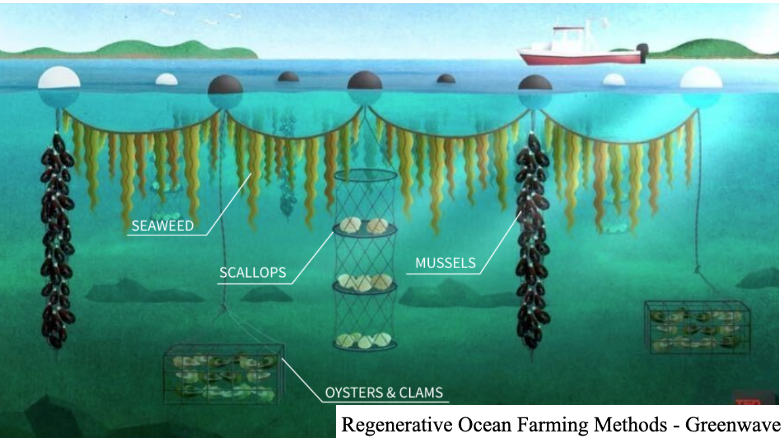To: Danielle Blacklock, Director of the NOAA Fisheries Office of Aquaculture
BLUF: To mitigate anthropogenic threats to seafood species and marine ecosystems, NOAA must employ their Aquaculture Opportunity Area (AOA) assessments to implement regenerative ocean farming (ROF) in all suitable coastal areas. ROF will (1) counter ocean acidification (OA), (2) prevent harmful algal blooms (HABs), and (3) provide a more resilient, plentiful, and environmentally beneficial array of local seafood than traditional monoculture operations.
Background
Marine industries are becoming increasingly vulnerable as “ocean acidification adversely [affects] food production from shellfish aquaculture” (IPCC, 2022). Seafood is further suffocated by HABs that deplete aquatic oxygen levels and organism health, “[threatening] the economy and livelihoods of many coastal communities” (IPCC, 2022). In tandem, OA and HABs contribute to dramatic declines in water quality and jeopardize ocean and human prosperity.
The U.S. must swiftly modernize existing monoculture methods through transitioning to ROF if we want to retain the social, environmental, and economic benefits provided by our working waterfronts and marine habitats.
Turning the Tide
To ameliorate the crises caused by excess CO2 and nutrient inputs–exacerbated via unsustainable finfish aquaculture–NOAA must funnel resources into ROF.

This budding method of open-ocean aquaculture involves the co-cultivation of shellfish and seaweed species close to our shores. Growing these organisms is more sustainable than raising terrestrial species as they require no freshwater, no fertilizer, and no arable land to flourish. Further, ROF species don’t require the nutrient-loaded food inputs that finfish demand: seaweeds sustain themselves through photosynthesis while bivalves filter feed on free-floating algae. And while monoculture oyster farms often require dozens of acres, ROF operations only occupy a few acres of shoreline and produce more food (Smith, 2016). With this greater efficiency, ROF can help the US bolster our ‘blue economy’ while limiting human intrusion on our natural marine spaces (“Global Study,” 2022).
Benefits

Initial curiosity about ROF has grown into grounded action as research continues to reveal the vast environmental and economic benefits provided by co-cultivation. A Maine study notably uncovered the “phytoremediation halo effect” of ROF: farmed sugar kelp locally reduces the effects of OA on surrounding ocean life by improving water chemistry as it draws in carbon (Arnold, 2018). Due to this reduced acidity, mussels grown alongside kelp fronds had “denser and thicker” shells and larger meats compared to those grown in monoculture environments, says Dr. Nicole Price (2018). Such improvements in shellfish growth can transfer to significant economic gains within the seafood industry as less individuals are damaged during transport and meat can be sold at higher prices. The researchers also found that sugar kelp continues to photosynthesize and absorb excess nitrogen remarkably well in future high-CO2 scenarios, providing hope for lasting water quality improvements, industry earnings, and seafood production.
Bivalves are also exceptional water filters, drawing in nitrogen from the environment to build their shells and tissues. An average farm with 100,000 oysters can filter up to 5,000,000 gallons of water every day, removing excess nutrients that could otherwise trigger HABs (NOAA Fisheries, 2020). When reared together, seaweed and shellfish farms remove an average of 575 pounds of nitrogen per acre each year (Theuerkauf et al., 2019). Governments can save up to $7,739/acre/year using shellfish filtration and up to $10,110/acre/year using seaweed filtration instead of investing in traditional marine nutrient remediation methods–such as water treatment plant upgrades. Further, Theuerkauf found that ROF environments increased the abundance of local fish species by 160% compared to fish stocks in corresponding natural rock reef habitats (2019). This added an average of 94 pounds per acre to local fishery landings.
Policy Recommendations
- NOAA Aquaculture should further investigate and invest in ROF using resources provided for AOA projects.
- Following the completion of evaluations in the Gulf of Mexico and Southern California, AOAs should turn their attention to New England, the Pacific Northwest, and Alaska where open waters are cold enough to support flourishing kelp and shellfish populations.
- NOAA should specifically support ROF development in areas where natural habitats have been lost and nutrient management is needed (Theuerkauf et al., 2019).
- Efforts to expand ROF operations must always forefront local contexts because of the unique ocean uses (ex. recreation, offshore wind), fragile ecosystems, and marine chemical properties that exist across the country.
Conclusion
When done intentionally and with continued surveillance, ROF provides a low impact and sustainable way to produce seafood that uniquely contributes to ecosystem recovery and resilience in the face of climate change. NOAA’s AOA assessments are the perfect avenue to ensure that ROF reaches its goals of: (1) countering OA, (2) preventing HABs, and (3) superseding monoculture to improve food security and coastal ecosystem health.